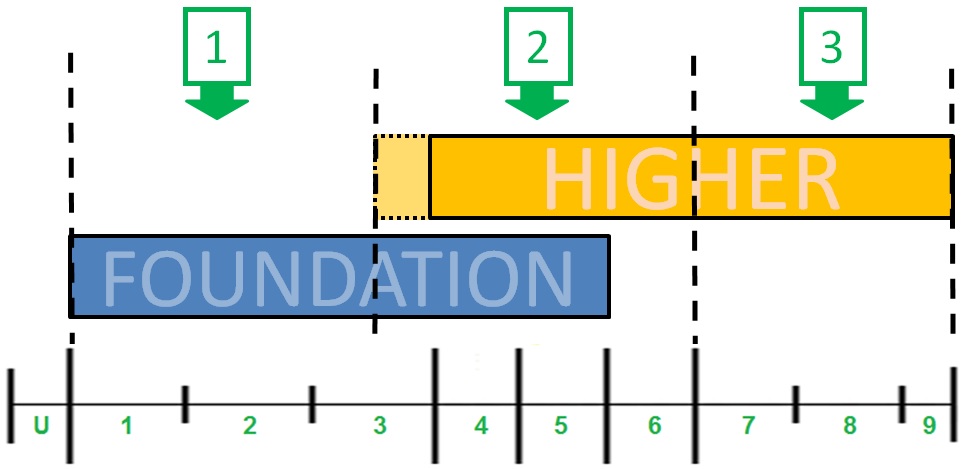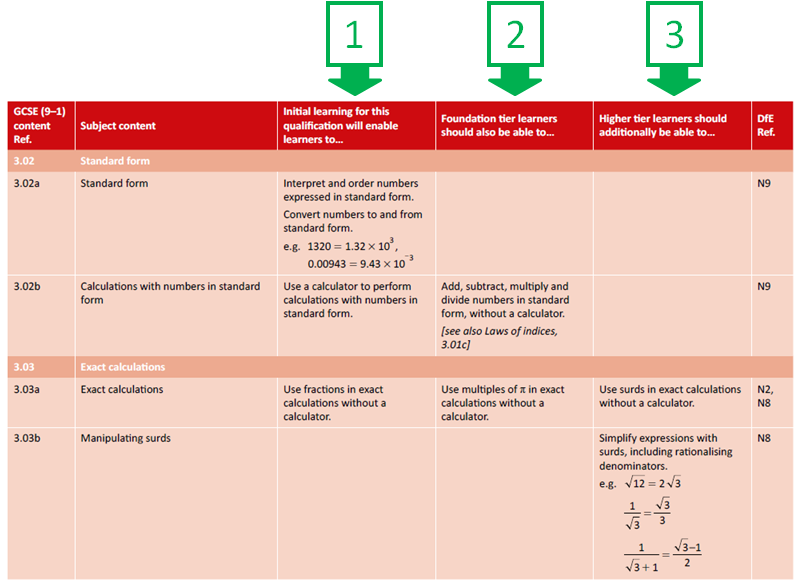Using the OCR Specification to deliver GCSE (9-1) Mathematics content more effectively
06 December 2018
In this blog we will take a look at how GCSE (9-1) Mathematics content is required to be assessed, how this is presented in the OCR GCSE (9-1) Mathematics specification and how it can be used to tailor schemes of work for particular abilities of learners.
Summer 2018 saw a large increase in the number of students taking GCSE (9-1) Mathematics with OCR. Many of these were at Foundation tier (our entry in summer 2018 was 61% Foundation and 39% Higher). Feedback from schools has told us that one main reason for bringing students to OCR, in particular at Foundation, has been how the layout and presentation in our specification enables content to be delivered more effectively to students across the ability range.
How content is required to be assessed
In Foundation tier papers, Ofqual requires all boards to target:
- 50% of marks at grade 1 to the lower part/half of grade 3,
- 50% of marks at the upper part/half of grade 3 to grade 5.
At Higher tier all boards are required to target:
- 50% of marks at grade 4 to grade 6,
- 50% of marks at grade 7 to grade 9.
Looking at the way the tiers overlap, this gives us three sections of content, as seen below.

How content is presented in the OCR GCSE (9-1) Mathematics specification
The three sections above are mirrored in the three columns of the OCR J560 GCSE (9-1) Mathematics specification, as seen below.

At Foundation tier, the 50% of the marks aimed at the lower demand (marks at grade 1 to the lower part/half of grade 3) will draw on just content from column 1 of the specification (titled ‘Initial learning…’).
The second 50% of marks (marks at the upper part/half of grade 3 to grade 5) will assess some content from column 2 of the specification (‘Foundation tier learners…’), but crucially will also assess some content from column 1 too at this level of demand.
At Higher tier, the 50% of the marks aimed at the lower demand (marks at grade 4 to grade 6) will assess content from columns 1 and 2 of the specification.
The second 50% of the marks (at grade 7 to grade 9) will assess some content from column 3 of the specification (‘Higher tier learners…’), but will also assess some content from columns 1 and 2 as well.
The specification is also progressive, so understanding content in column 2 would be based on any content in column 1 and any content in column 3 on any content in columns 1 and 2.
How the OCR specification can be used to target schemes of work
For Foundation tier students, secure knowledge of the content in column 1 of the specification is key, as it will likely make up more than half of the papers they sit and also be crucial understanding for content from column 2. How much time is spent on this content versus how much time is spent on column 2 will be down to the level of the students.
This greater specificity of content has led many schools to particularly bring their Foundation tier entries to OCR, as it enables them to target their Schemes of Work and teaching effectively to the appropriate level for their students.
At Higher tier, content from columns 1 and 2 would be making up more than 50% of the assessment, with content from column 3 only coming up in the grade 7 to grade 9 marks. The breakdown of content across the columns of the specification therefore enables greater targeting of teaching at Higher tier too, as appropriate for different levels of students.
This presentation of the content in the specification is appreciated by many teachers for the way it enables the teaching of content to be tailored to their students, leading to them making the move to our GCSE (9-1) Mathematics. We hope to see more schools benefiting from this in forthcoming exam series.
If you have any queries or questions on our maths questions, you can comment below, email us via maths@ocr.org.uk, call us on 01223 553998 or Tweet us @OCR_Maths.
About the author
Neil Ogden, OCR Maths Subject Advisor
 Neil has worked in a variety of qualification lead roles at OCR for a number of years, having joined the Maths team in 2012. Neil led the development of the new GCSE (9-1) maths qualification (J560) and following its accreditation, the majority of his time is currently spent supporting teachers delivering the qualification.
Neil has worked in a variety of qualification lead roles at OCR for a number of years, having joined the Maths team in 2012. Neil led the development of the new GCSE (9-1) maths qualification (J560) and following its accreditation, the majority of his time is currently spent supporting teachers delivering the qualification.
Neil also supports a range of OCR maths qualifications including the Functional Skills and Entry Level qualifications, as well as regularly publishing to the OCR maths Twitter account.